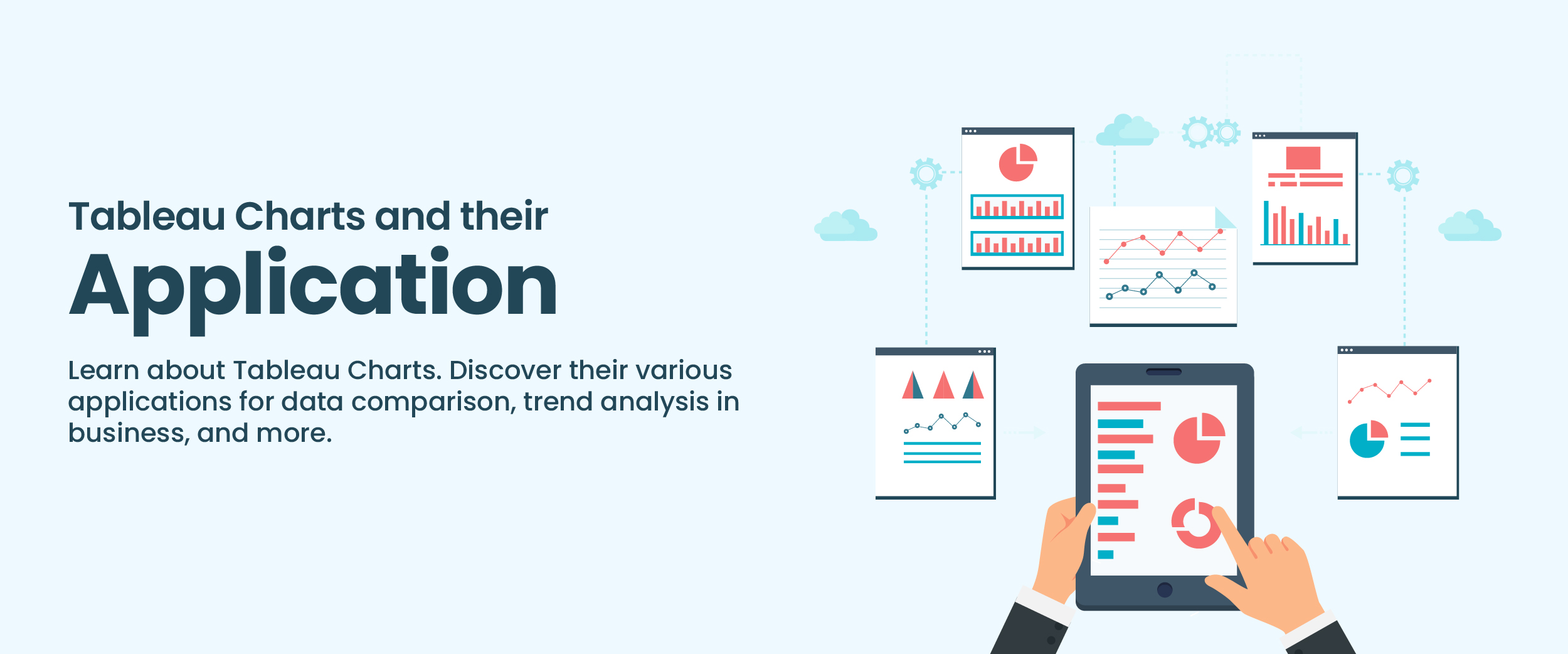Practical Applications of Tableau Charts – The Complete Guide
Tableau is a sophisticated data visualization application that allows users to build interactive and aesthetically attractive charts, graphs, and dashboards. It offers a user-friendly interface that enables anyone to connect to multiple data sources, turn raw data into useful insights, and show them in a visually attractive way. Tableau charts help people to examine data, uncover trends, and convey discoveries efficiently.
Importance of Data Visualization
Data visualization plays a significant role in comprehending and interpreting complicated data sets. It includes expressing data graphically using charts, graphs, and other visual features, making it simpler for users to comprehend crucial information and insights.
Here’s why data visualization is important:
- Simplifies Complexity: Visualising data simplifies intricate information by presenting it straightforwardly. It allows users to recognize patterns, trends, and correlations that could be otherwise challenging to detect in unstructured data.
- Enhances Understanding: Visual representations assist users in grasping material quickly and readily. Visual cues, such as colors, forms, and sizes, assist in transmitting information more naturally, allowing for improved understanding and analysis.
- Facilitates Decision-Making: Data visualization enhances decision-making by giving a visual context and emphasizing crucial findings. When data is displayed graphically, decision-makers may spot trends, correlations, and outliers, leading to educated and data-driven judgments.
- Promotes Communication and Collaboration: Visualising data makes it simpler to explain results to stakeholders, team members, or clients. Visual representations assist successful communication, allowing people to explain complicated information simply and engagingly.
- Enables Exploration and Discovery: Interactive data visualizations, such as those generated using Tableau, enable users to explore and engage with data in real-time. This interaction enables deeper research, hypothesis testing, and the finding of hidden insights.
Applications of Tableau Charts
Overall, Tableau charts find applications throughout numerous businesses and areas, from business analytics and sales to finance human resources, and healthcare, They help professionals to obtain insights, make educated choices, and generate good results in their respective fields.
Here are some of the areas where it is in use:
A. Business Analytics and Reporting: Tableau charts have numerous uses in corporate analytics and reporting. They let organizations assess different elements of their operations, such as sales success, consumer behavior, and operational efficiency. They offer visual representations that assist in detecting trends, patterns, and outliers, aiding data-driven decision-making and strategic planning.
B. Sales and Marketing: They play a key part in sales and marketing operations. They aid in assessing sales funnels, tracking conversion rates, and measuring marketing campaign performance. By displaying sales data, customer demographics, and marketing indicators, firms can spot opportunities, improve tactics, and allocate resources effectively.
C. Financial Analysis: They are essential in financial analysis and planning. They help financial experts to examine income sources, manage costs, and estimate profitability. Financial charts in Tableau give insights into budgeting, forecasting, and financial performance, supporting strategic financial decision-making.
D. Human Resources: Tableau charts have been used in human resources management. They aid HR workers in reviewing employee data, monitoring performance indicators, and measuring workforce diversity. With these, HR departments can examine turnover rates, training efficacy, and talent acquisition analytics, helping them to make educated choices and enhance staff management.
E. Healthcare: In the healthcare business, they serve a critical role in evaluating patient data, monitoring medical results, and improving healthcare delivery. Healthcare practitioners may monitor health trends, track illness outbreaks, and identify areas for improvement. These charts aid in resource allocation, patient care management, and performance assessment, helping to improve healthcare decision-making.
This table will help you to understand:
| Business Analytics and Reporting | Visual graphical reporting, representation, and analysis of business data help organizations to take quick data-driven decisions. |
| Sales and Marketing | Tableau reports offering insights into the sales funnel, customer behaviors, trends, and forecasts to the sales and marketing team. |
| Financial Analysis | Comprehensive data analytics helps the finance and leadership teams to get a quick assessment of the income sources, production and logistics costs, and estimate profitability. |
| Human Resources | It helps HR professionals to analyze employee data, monitor performance indicators, and measure workforce diversity. |
| Healthcare | Tableau analysis shares insights on health trends, tracks illness outbreaks, identify areas for improvement and medical results. |
Become a data scientist by enrolling in the best data science placement guarantee courses.
Tips for Creating Effective Tableau Charts
Here are some of the tips for you to create an effective tableau chart.
- Choose the proper chart type: Selecting the appropriate chart style is vital for successfully displaying your data. Consider the nature of your facts and the message you want to express. Choose a chart type that best reflects your data and aids simple interpretation.
- Simplify and Declutter: Keep your charts clear and uncluttered to prevent overwhelming your viewers. Remove superfluous gridlines, labels, and embellishments that might distract from the essential content. Focus on the essential data elements and make them simple to grasp at a glance.
- Use Suitable Colors and Labels: Choose colors that improve the visual appeal of your charts and give clarity. Use contrasting colors to separate data categories or emphasize critical features. Ensure that labels are precise and simply provide vital information without overwhelming the graphic.
- Provide Context and Interaction: Make your charts more interesting by offering context and enabling interactivity. Add titles, subtitles, and captions to offer a clear understanding of the data being shown. Utilise tooltips, filters, and drill-down options to allow users to explore and evaluate the data on their own.
By following these suggestions, you can design charts that effectively convey your data, promote comprehension, and drive insights and decision-making.
Types of Tableau Charts
Tableau provides a wide selection of charts for efficiently visualizing data. Some of the basic charts are as follows:
A. Bar Charts
Bar charts are one of the most often used and adaptable forms of charts in Tableau. They depict data using rectangular bars of variable lengths or heights, where the length or height of each bar denotes the magnitude of a given category or value. Bar charts are useful for comparing various categories or groups and illustrating the distribution of data.
Bar charts can be used to show category data such as sales numbers by month, product categories, or customer groups. They give a clear visual depiction of the relative values across distinct categories, enabling users to see patterns, comparisons, and outliers quickly. In Tableau, users may alter the look of bar charts by changing colors, labels, and axis settings to increase the visual impact.
B. Line Charts
Line charts in Tableau are great for depicting patterns over time or continuous data points. They link data points with straight lines, producing a visual depiction of how values change over a specific time. Line charts are commonly used in different industries, such as banking, sales, and scientific research, to monitor and evaluate data trends.
Line charts are especially helpful for evaluating time series data, such as stock prices, website traffic, or temperature fluctuations. They enable users to detect patterns, spot variations, and make forecasts based on past data. With Tableau, users may add extra elements to line charts, like markers, tooltips, and reference lines, to give more context and insights.
C. Pie Charts
Pie charts portray data as proportionate segments of a circle, where each segment represents a separate category or component of a whole. The size of each segment correlates to the percentage or proportion of the data it represents. Pie charts are widely used to display the makeup of a dataset or to compare the relative sizes of various groups.
Tableau provides extensive customization options for pie charts, enabling users to set colors and labels and even explode certain areas for emphasis. However, it is crucial to utilize pie charts wisely and acknowledge their limits. They are best suited for presenting a limited number of categories or comparing basic proportions. When working with huge datasets or categories with comparable proportions, alternative chart formats give greater clarity and readability.


Types of Advanced Tableau Charts
Some of the advanced Tableau charts are as follows:
A. Scatter Plots
Scatter plots are strong visualization tools in Tableau that depict the connection between two variables. They depict data points as individual dots on a graph, with each dot referring to a particular data observation. Scatter plots are excellent for spotting trends, relationships, and outliers within datasets.
In Tableau, users may build scatter plots by adding variables to the X and Y axes, indicating the two variables of interest. By adding other variables, such as color or size, users may combine more parameters into the scatter plot and acquire deeper insights into the data linkages. Scatter plots are extensively used in subjects such as social sciences, economics, and environmental studies to evaluate data and identify patterns or relationships.
B. Heat Maps
Heat maps in Tableau employ color gradients to illustrate the density or intensity of data values inside a two-dimensional grid. They are especially effective for viewing huge datasets and spotting patterns or abnormalities. Heat maps may be constructed by mapping variables to both the rows and columns of the grid, and the color hue symbolizes the value intensity.
Tableau lets users modify the color palettes and establish threshold values for heat maps, making it simpler to analyze the data trends. Heat maps are commonly utilized in domains including geographic analysis, risk assessment, and sports analytics. They give a visually appealing and straightforward approach to evaluating data across numerous dimensions concurrently.
C. Tree Maps
Treemaps are hierarchical visualization tools in Tableau that present data using layered rectangles. Each rectangle represents a category, and its size correlates to a certain value or percentage within that category. Treemaps are useful for displaying hierarchical data structures and demonstrating the relative sizes of various categories and subcategories.
Tableau allows users to construct treemaps by assigning data fields to the hierarchical structure and defining the size of the rectangles depending on the data values. This enables a clear depiction of the data structure and simplifies the identification of relevant groups or subcategories. Treemaps find applications in several disciplines, including organizational architecture, disk utilization analysis, and portfolio allocations.
Conclusion
Tableau charts are powerful tools for data visualization, allowing users to display and analyze data in a visually engaging and straightforward way. These charts have practical applications across different sectors, including business analytics, sales and marketing, financial analysis, human resources, and healthcare. By employing these charts organizations and professionals may get useful insights, make data-driven choices, and effectively convey complicated information to stakeholders. Embracing Tableau’s visualization skills may unleash the full potential of data analysis and boost decision-making processes.







